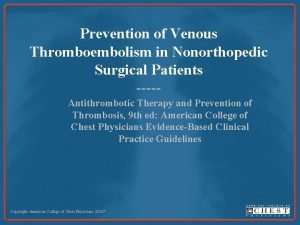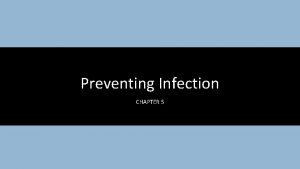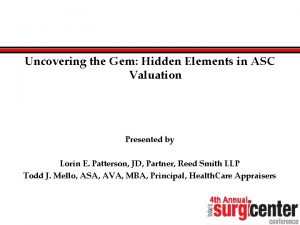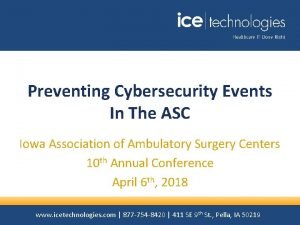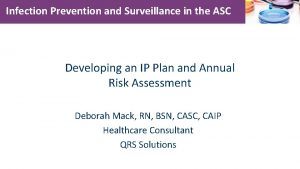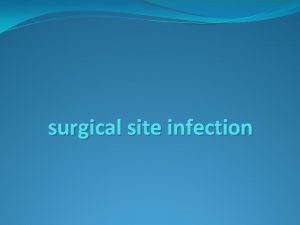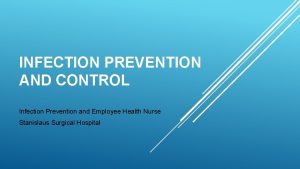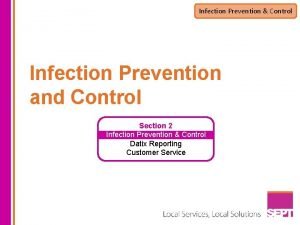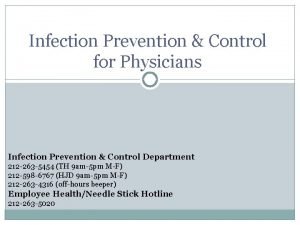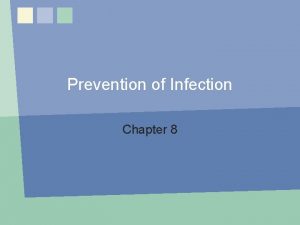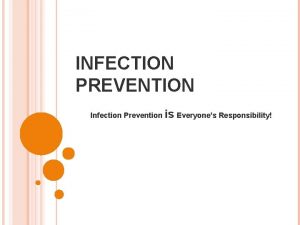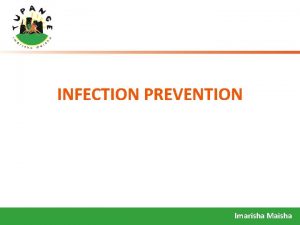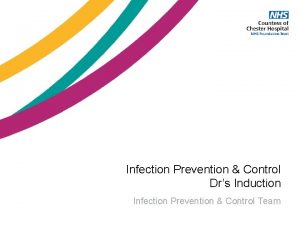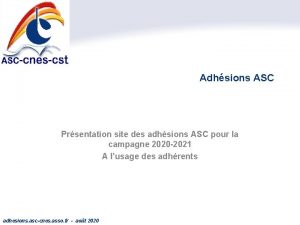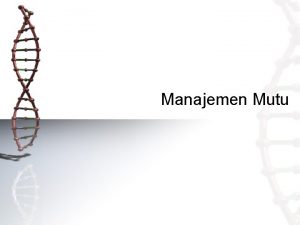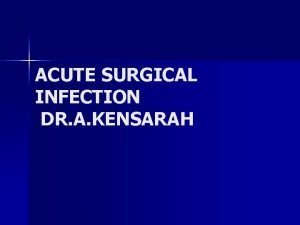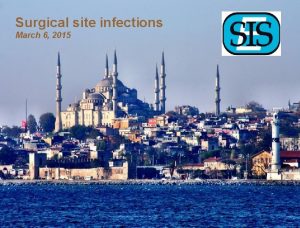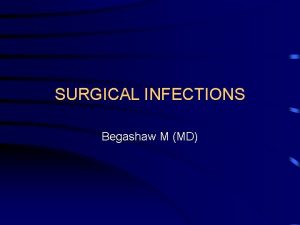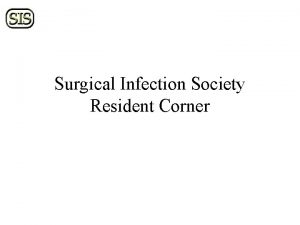Infection Prevention and Surveillance in the ASC Surgical


















- Slides: 18

Infection Prevention and Surveillance in the ASC Surgical Attire and Aseptic Technique Deborah Mack, RN, BSN, CASC, CAIP Healthcare Consultant QRS Solutions

Learning Objectives • Describe the standards of environmental cleaning how to monitor compliance • Identify important changes to recommendations that pertain to surgical attire • Review aseptic techniques utilized in the surgical setting

Surgical Attire

What’s New? • Lab Coats – If worn , cover apparel should be clean – Lab coats could be contaminated with large numbers of pathogens – Cover apparel should be discarded after daily use • Head coverings – No recommendations can be made for the type of head covering worn in the semi-restricted and restricted areas. – The health care organization may determine what type of head coverings will be worn – No evidence of association between surgical site infections and the type of surgical head covering material – Cloth hats should be determined by the healthcare facility – Skull hats ok if all of the hair is covered

What’s New? • Should Peri-Operative team members remove surgical head coverings when leaving the restricted area? – Surgical head coverings should be removed at the end of the shift and when contaminated – The purpose of the head covering is to contain hair and minimize microbial dispersal • Wearing earrings or necklaces in the peri-operative area? – No recommendations can be made about wearing earrings or necklaces in the semi-restricted areas – Wearing a necklace or uncovered earrings while scrubbed may pose a risk that the jewelry will fall into the sterile field

What’s New • Should long sleeves be worn in the Peri-Operative setting? – Arms should be covered during performance of the patient skin antisepsis – Although the benefits of wearing long sleeves during skin prep is likely to exceed the harms, further research is needed – Healthcare facilities can decide • Wearing personal clothing under scrub attire? – No recommendation can be made regarding personal clothing under scrub attire – Healthcare facilities should establish a process to manage personal clothing

What’s New? • Wearing scrub attire outside of the healthcare facility? – Surgical attire should be removed before personnel leave the healthcare facility – Benefits of removing the surgical attire outweigh the harms – Moderate evidence supports changing clothes to reduce the transport of pathogenic micro-organizms from the facility into the home or community

What’s New? • Briefcases and personal items taken into the restricted area? – Healthcare organizations should establish policies to prevent contamination of the semi-restricted and restricted areas from personal items ( briefcases, backpacks) – The policy may include cleaning or placing the items in a designated area within the OR suite

What’s New • Laundering of scrub attire – Scrub attire should be laundered in a healthcare –accredited laundry facility OR – At the healthcare facility according to state requirements OR – At the healthcare facility according to the CDC laundering recommendations in the absence of state requirements – Home laundering may not kill all pathogens • Shoes in the Peri-Operative area – Shoes should be clean – Shoes should meet safety requirements

Aseptic Technique

Aseptic Technique • Keep operating doors closed at all times to maintain proper positive pressure and promote effective air exchange • Before donning sterile gowns and gloves, surgical hand antisepsis should be performed • Personnel will wear scrub attire, caps, masks, eye protection, and sterile gowns and gloves to prevent microbial transference to the sterile field • Surgical gowns will be of sufficient size to adequately cover the scrubbed person

Aseptic Technique • Scrubbed personnel will inspect gloves for integrity after donning them • Gloved hands must always be in sight and kept at waist level or above. Below the waist is contaminated • Arms are not to be folded under axillae • Sterile gloves that become contaminated will be changed as soon as possible

Aseptic Technique • All items will be inspected immediately before presentation to the sterile field for proper packaging, processing, seal, package container integrity, and inclusion of a sterilization indicator • Check package integrity by expiration, if applicable, and appearance of sterilizer indicator tape or strip to be checked before opening on sterile field. • Event-related sterility is based on the concept that “sterility is not altered over time, but may be compromised by certain events of environmental conditions. ” • Shelf life refers to the time an item may remain on the shelf and still maintain its sterility. Shelf life is influenced by the type of packaging used, storage conditions, humidity, temperature, transport conditions, use of dust covers, and the amount of handling the item receives

Aseptic Technique • After a sterile container is opened, the edges are considered unsterile • The edge of an irrigation bottle cap is considered contaminated once the cap has been removed from the bottle • Avoid splattering solutions when pouring onto sterile surfaces • Medications will be delivered to the sterile field in an aseptic manner. Stoppers will not be removed from vials for the purpose of pouring medications. Sterile transfer devices (e. g. , sterile vial spike, plastic catheter), will be used to dispense medications to the sterile field

Conscience • When a break in sterile technique occurs, corrective action should be taken immediately unless the patient’s safety is at risk • When a break in sterile technique occurs and cannot be corrected immediately the organization will determine how it will be reported and recorded, and the wound classification will be adjusted accordingly and documented on the operative record

Sample Interior Slide (44 pt) QUESTIONS? Sample Caption (32 pt)

References • Guidelines for Surgical Attire In: AORN Guidelines for Perioperative Practice updated April 2019 • CMS Exhibit 351 Infection Control Surveyor Worksheet – www. cms. gov/Regulations-and. Guidance/Manuals/downloads/som 107 _exhibit_351. pdf

Infection Control is Everyone’s Responsibility! Deborah L. Mack, RN, BSN, CASC, CAIP QRS Solutions dmack 1957@gmail. com 925 -899 -0739
 Primary prevention secondary prevention tertiary prevention
Primary prevention secondary prevention tertiary prevention Lyphadenitis
Lyphadenitis Surgical site infection bundle checklist
Surgical site infection bundle checklist Chapter 19 disease transmission and infection prevention
Chapter 19 disease transmission and infection prevention Chapter 19 disease transmission and infection prevention
Chapter 19 disease transmission and infection prevention Chapter 19 disease transmission and infection prevention
Chapter 19 disease transmission and infection prevention Chapter 16 infection control and standard precautions
Chapter 16 infection control and standard precautions Prevention of vte in nonorthopedic surgical patients
Prevention of vte in nonorthopedic surgical patients Define infection prevention chapter 5
Define infection prevention chapter 5 Fas 109 accounting for income taxes
Fas 109 accounting for income taxes Asc 740
Asc 740 Gem asc
Gem asc Academic success center
Academic success center Crismani attachment
Crismani attachment Asc cybersecurity
Asc cybersecurity Asc 340-40-25-1
Asc 340-40-25-1 Stress breaker dental
Stress breaker dental Deloitte asc 740 guide
Deloitte asc 740 guide Asc college panvel
Asc college panvel







